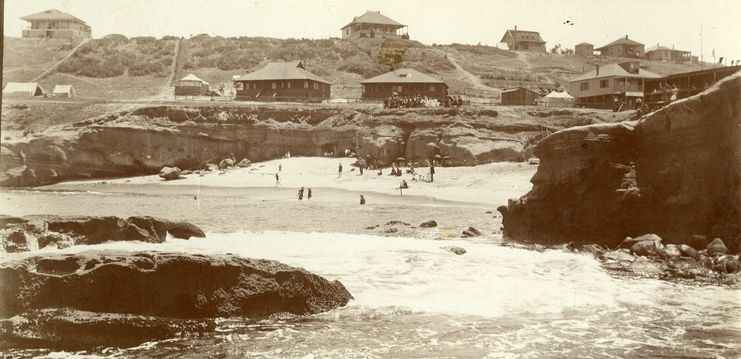The New La Jolla Park Coastal Historic District
“How we loved her shell-strewn beaches, her unstable sand dunes, her legend-haunted caves, her rock-pools teeming with life and color, her wave-carved Cathedral Rock, even her dusty roads and grass-grown footpaths which lured us to unexplored wonders of sea and land.”~ Ellen Browning Scripps, recalling her first visits to La Jolla in the 1890s.

‘The La Jolla Historical Society and La Jolla Parks & Beaches, Inc. have nominated the La Jolla Park Coastal Historic District for a 2024 award from Save Our Heritage Organisation’s People in Preservation.’
The “La Jolla Park Coastal Historic District,” a dramatic stretch of coastline that is part of the unceded ancient homeland and traditional territory of the Kumeyaay Nation, was listed on the National Register of Historic Places on May 9, 2024. It is recognized as the focal point for the planning and development of La Jolla between 1887 and 1940. The district, which includes La Jolla Cove and the Children’s Pool, is one of the most popular visitor attractions in Southern California.
The district was nominated under Criterion A: “Is associated with events that have made a significant contribution to the broad patterns of our history.”
Anchored by the 5.6-acre Ellen Browning Scripps Park, the district extends along the shoreline from Coast Walk in the north to Whale View Point in the south. The central unifying artery is the curvilinear Coast Boulevard, identified on the 1887 Subdivision Map for La Jolla Park. The roadway provides spectacular views of the coastline framed by belvederes, palm trees, and sweeping green lawns. Thirty-five contributing resources—ten buildings (including two previously listed), eight sites, and seventeen structures—are located along the entire seaside length of the district. They include five public beaches; four stairways connecting the coast to the commercial district of La Jolla; Coast Walk; and Coast Boulevard.
Public access to the waterfront—the area encompassed by the La Jolla Park Coastal Historic District—was central to both the economic success and cultural identity of early La Jolla. At a time of rapid industrialization and urbanization, La Jolla’s coastline—with its dramatic sea arches and caves—drew visitors seeking emotional and physical rejuvenation in Nature. It offered the chance to observe and study marine life, swim in protected coves, and engage in other recreational activities. Over one hundred years later, much of the shoreline remains accessible to the public, drawing thousands of visitors from around the world to see one of the most beautiful sites in California.
The La Jolla Coastal Historic District is the first nationally recognized district in La Jolla, and one of only twenty-six in San Diego County. It is also listed on the California Register of Historic Resources. Some individual features are also listed on the City of San Diego Register of Historic Resources. The district is significant for the following reasons:
- It helps to preserve and protect a unique cultural landscape that is part of the historic fabric of La Jolla, and informs future management of this sensitive coastline,
- It describes the historic context for the town’s planning, one linked to the nineteenth century American Park Movement, when the founders envisioned the role coastal resources would play in the education, health, and well-being of the community and commercial vitality of La Jolla village,
- It celebrates the setting for the area’s unique marine resources–underwater canyons, kelp forests, and rocky shorelines, including the coastal birds and wildlife such as seals and sea lions–that have attracted people to La Jolla for over 100 years.
- It identifies sites and structures of significance to the planning and development of La Jolla: Coast Walk Trail, Devil’s Slide Footbridge, Cave Store and Tunnel, historic cottages, Casa de Manana Hotel, and the Adult Recreation Center, Ellen Browning Scripps Park, and the Children’s Pool. Contributing resources also include village stairways, belvederes, walls and bridges.
- Just completed in July 2024 is our detailed report on the threatened and failing infrastructure along the Historic District.
- It has been identified by California’s Coastal Conservancy as a potential part of the California Coastal Trail, an integrated network of trails that, when completed, “will provide a multi modal opportunity to walk and bike the length of California’s 1,230-mile-long coast.”
The nomination of La Jolla Park Coastal Historic District to the National Register of Historic Places was authored by Seonaid McArthur, art historian and preservationist, and Molly McClain, professor of history at the University of San Diego, on behalf of the La Jolla Historical Society. Architectural historian Diane Kane contributed information on The Children’s Pool and provided technical edits.
The La Jolla Park Coastal Historic District is an example of what can be achieved through dedicated preservation efforts and a collaborative community.
Below are PDFs of background information of the first nationally recognized Historical District in La Jolla.
